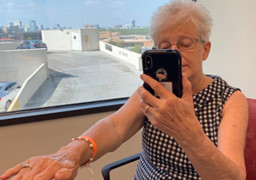




 |
 |
 |
|||
 |
 |
 |
 |
 | |
 |
 |
 | |


| 미디어 브리핑스 | 내서재담기 |


  |
 |  |
어떤 신기술이 세상을 극적으로 변화시킬까? 세계 최고의 연구소에서 나오는 놀라운 혁신을 독점 소개합니다.
.jpg)
펜실베이니아주립대학교(Penn State)와 휴스턴 감리 병원(Houston Methodist Hospital)의 연구원들이 획기적인 새로운 도구를 만들었다. 스마트 폰과 상호 작용을 통해 감지되는 환자의 언어 능력 이상과 안면 근육의 움직임만으로 수 분 이내에 응급실 의사의 정확도로 뇌졸중을 진단할 수 있는 도구가 그것이다.
환자가 뇌졸중 증상을 경험하면 1분, 1초가 중요하다. 그러나 뇌졸중 진단과 관련하여 응급실 의사는 옵션이 제한되어 있다. 비싸고 시간이 많이 걸리는 방사능 기반 스캔을 위해 환자를 보내거나 임상 진단 테스트를 즉시 수행할 수 없는 신경과 전문의에게 전화를 건다.
이 연구팀의 새로운 접근 방식은 전산 안면 동작 분석과 자연어 처리를 사용하여 환자의 얼굴이나 음성의 이상(예를 들어, 처진 뺨 또는 불분명 한 말)을 식별하여 뇌졸중이 의심되는 실제 응급실 환자 중 뇌졸중의 존재를 확인하는 최초의 방법이다.
결과는 응급실 의사가 환자의 중요한 다음 단계를 보다 신속하게 결정하는 데 도움이 될 수 있다. 이것은 응급 상황에서 뇌졸중 진단을 돕는 인공지능의 첫 번째 응용 프로그램 중 하나이다. 그리고 궁극적으로 이 애플리케이션은 간병인이나 환자가 병원에 도착하기 전에 자체 평가를 내리는 데 활용될 수 있다.
컴퓨터 모델을 훈련시키기 위해 연구원들은 텍사스 휴스턴 감리교 병원에서 뇌졸중 증상을 경험하고 있는 80명의 이상의 환자로부터 데이터 세트를 구축했다. 각 환자는 스마트폰에 녹음되는 동안 음성 및 인지 의사소통을 분석하기 위한 음성 테스트를 수행하도록 요청받았다.
자연스러운 환경에서 안면 데이터를 수집하면 이 작업은 더 강력해지고 실제 임상 응용 프로그램에서 유용하게 활용되어, 궁극적으로 뇌졸중의 원격 진단 및 자체 평가에 이 방법을 실제로 사용할 수 있다.
휴스턴 감리 병원의 데이터 세트에서 모델을 테스트 한 결과, 연구원들은 CT 스캔과 같은 추가 테스트를 사용하는 응급실 의사의 임상 진단에 필적하는 성능으로 79%의 정확도를 달성했음을 발견했다. 중요한 것은 이 도구를 사용하면 4분 만에 환자를 진단내릴 수 있어 뇌졸중 진단에 귀중한 시간을 절약할 수 있다!
뇌졸중이 진행되는 매분마다 수백 만 개의 뉴런이 죽어가기 때문에 이것은 매우 중요하다. 심한 뇌졸중의 경우 환자가 응급실에 들어가는 순간부터 의사는 분명히 뇌졸중을 인식한다. 그러나 연구에 따르면 뇌졸중의 대부분은 최종 판정에 앞선 진단 과정에서 몇 시간 지연될 수 있으며 그때까지 환자는 가능한 최상의 치료를 받을 수 없다. 따라서 뇌졸중을 일찍 식별할수록 환자에게 더 좋은 옵션이 가능하다. 이를 위해서는 뇌졸중 조기 진단이 필수이다!
시스템이 뇌졸중 초기 단계에서의 진단을 향상시킬 수 있다면, 해당 환자는 적절한 수준의 리스크에만 노출되고 병원은 잠재적 환자들을 놓치지 않을 것이다.
오늘날 뇌졸중에 대한 훌륭한 치료법, 의약품 및 프로세스가 있다. 그러나 우리는 여전히 매우 원시적이고 부정확한 진단을 가지고 있다. 이 새로운 시스템은 이러한 진단 격차를 해결하는 데 일조를 할 것으로 보인다.
References
Penn State University, October 2020, “New tool can diagnose strokes with a smartphone,” by Jessica Hallman. © 2020 The Pennsylvania State University. All rights reserved.
To view or purchase this article, please visit:
https://news.psu.edu/story/636014/2020/10/20/research/new-tool-can-diagnose-strokes-smartphone
New tool can diagnose strokes with a smartphone chr(124)_pipe Penn State University (psu.edu)
 |  |
A new tool has been created by researchers at Penn State and Houston Methodist Hospital. It can diagnose a stroke with the accuracy of an emergency room physician within minutes based only on abnormalities in a patient’s speech ability and facial muscular movements that are detected via interactions with a smartphone.
When a patient experiences the symptoms of a stroke, every minute counts. But when it comes to diagnosing a stroke, emergency room physicians have limited options: send the patient for expensive and time-consuming radioactivity-based scans or call in a neurologist, who may not be immediately available to perform clinical diagnostic tests.
The team’s novel approach is the first to identify the presence of stroke among actual emergency room patients suspected of stroke by using computational facial motion analysis and natural language processing to identify abnormalities in a patient’s face or voice, such as a drooping cheek or slurred speech.
The results could help emergency room physicians to more quickly determine critical next steps for the patient. This is one of the first applications of AI to help with stroke diagnosis in emergency settings. And ultimately, the application could be utilized by caregivers or patients to make self-assessments before reaching the hospital.
To train the computer model, the researchers built a dataset from more than 80 patients experiencing stroke symptoms at Houston Methodist Hospital in Texas. Each patient was asked to perform a speech test to analyze their speech and cognitive-communication while being recorded on an Apple iPhone.
The acquisition of facial data in natural settings makes this work robust and useful for real-world clinical applications, and ultimately empower this method for remote diagnosis of stroke and self-assessment.
Testing the model on the Houston Methodist dataset, the researchers found that its performance achieved 79 percent accuracy which is comparable to clinical diagnostics by emergency room doctors, who use additional tests such as CT scans. Importantly, the tool could save valuable time in diagnosing a stroke, with the ability to assess a patient in as little as four minutes!
This is critical because there are millions of neurons dying every minute during a stroke. In severe strokes, this is obvious to physicians from the moment the patient enters the emergency room, but studies suggest that in the majority of strokes, a diagnosis can be delayed by hours, and by that time a patient may not be eligible for the best possible treatments. The earlier you can identify a stroke, the better options (we have) for the patients. That’s what makes an early diagnosis essential!
If the system can improve diagnostics at the front end, then the right patients can be exposed to the right levels of risk and hospitals will not miss patients who would potentially benefit.
Today there are great therapeutics, medicines, and procedures for strokes, but we still have very primitive and inaccurate diagnostics. This new system is intended to address this diagnostic gap.
References
Penn State University, October 2020, “New tool can diagnose strokes with a smartphone,” by Jessica Hallman. © 2020 The Pennsylvania State University. All rights reserved.
To view or purchase this article, please visit:
https://news.psu.edu/story/636014/2020/10/20/research/new-tool-can-diagnose-strokes-smartphone
New tool can diagnose strokes with a smartphone chr(124)_pipe Penn State University (psu.edu)
